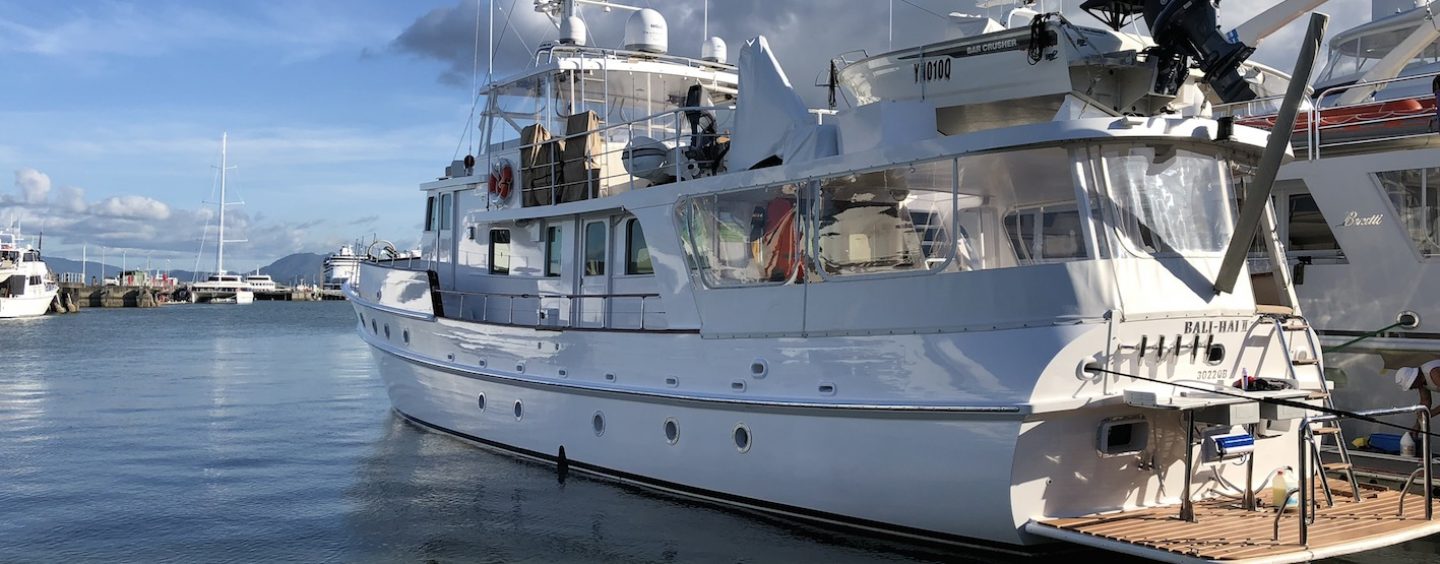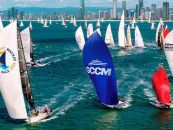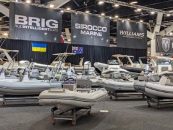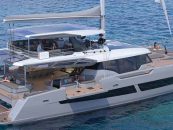Bali Hai II is a timber boat, with a measured length of 22.70 meters, a breadth of 5.58 meters, and a draft of 2.0 meters. I was engaged by the owner of Bali Hai II to prepare the vessel and undertake a seven- month expedition from May to November in 2018 to Far North Queensland (FNQ). My role was to conduct private charters for the owner and family members, including friends, who engaged in sports fishing and diving activities on the outer reefs up to 325NM north of Cairns, and stopping off for some cruising in the Whitsundays and Bunker Group islands, off Gladstone on our way south back to Brisbane.
PREPARING THE BOAT
Prior to the FNQ expedition, we completed a yard period with the builders Norman R Wrights in Brisbane to complete annual maintenance and servicing of all machinery and equipment, including some new additions such as the installation of a dive compressor for filling scuba cylinders and adding emergency oxygen (100%) cylinders to the vessel in the case of diving emergencies. All fire, safety, first aid and medical equipment were overhauled and updated including the installation of three new 8-person coastal life rafts, having all systems onboard tested. Serviced and operational is the key to any successful expedition.
Spare parts are extremely important and are something that cannot be overlooked, especially when undertaking remote offshore cruising. We stocked a huge number of spares onboard, which included items such as:
● spare Davey Raw water pumps for refrigeration and air conditioning
● spare water filters for the ships main fresh water supply and desalination unit
● spare high-pressure pump and motor for desalination unit
● spare starter motors for main engines
● spare fuel pumps for gensets
● raw water pumps and impellers for generators belts for main engines and generators
● fuel, air and oil filters for main engines and generators including pre-fuel filters (racors)
● fuses, light globes, marine grade electrical terminals and connectors
● spare hoses including heat-resistant hoses various sizes
● large assortment of hose clamps and stainless- steel fasteners
● Epoxy repair kit/bonding sealants gasket and pipe sealant
● emergency bungs for plugging up holes
● lift bags for lifting sunken objects from the sea floor
● spare start batteries and jumper leads
● outboard engine spare parts
● inflatable repair kits
Having adequate spare parts for your vessel’s plant and equipment greatly minimises the possibility of a trip being cut short and having to head back to port, which in some cases can be hundreds of nautical miles and can be extremely disappointing for the owners and guests.
On one occasion during our FNQ expedition, the port main engine fuel line split approximately 150 nautical miles north of Cairns. We used the epoxy repair kit to fix the fuel line, which lasted three weeks trouble-free until the end of that trip. We then had it professionally repaired once back in Cairns. By having the right tools, spares and equipment, most problems can be rectified at sea and further repairs can be carried out once the vessel has returned to port if required.
PRE-DEPARTURE
After the owner’s requirements were discussed, an experienced fishing guide and cook was engaged to take the guests reef fishing, assist with diving activities, and cooking for everyone onboard, consisting of Mediterranean cuisine.
The expedition plan was to undertake six, three week trips based out of Cairns with some charter guests arriving at Cairns, departing by light aircraft out of Lizard Island on completion of their voyage, and other guests meeting and departing the vessel at Lizard Island.
The vessel would be re-provisioned in Cairns, with the five to seven days of downtime in between each charter group. This meant we had to run a tight ship to meet the given deadlines that were already tight. After the six trips in FNQ were completed, we had one final three-week trip in the Whitsundays before heading south for a few days at Fitzroy Lagoon in the bunker group and then completing the final leg back to Brisbane.
Prior to departure, all guests had a safety induction and undertook an emergency drill by sounding the emergency alarm and going to the vessel’s muster station and donning their life jackets. The guests were then given a full brief on their upcoming voyage including questions and answers, followed by a welcome drink and meal before we would depart north for the start of their trip.
THE FNQ EXPEDITION
A usual day on the reef would begin at 5:30am where breakfast was prepared for the guests. Thereafter, they would depart for a morning of reef fishing or scuba diving at 07:00am and be back on board the mother ship at approximately 11:30am. At this time, they would have some free time and enjoy a freshly prepared lunch. At 13:30, the guests would then depart for an afternoon session of some reef fishing, light tackle game fishing or scuba diving and be back on board the mother ship at approximately 17:00pm to shower and enjoy a few sunset drinks. Dinner would be served at 19:00pm. The guests would then unwind with a few bottles of their favorite wine or watch a movie on the vessel’s Foxtel system. Our day would usually end at around 10:30-11:00pm once the guests had retired for the evening and the boat was cleaned and ready for the next day’s adventures.
One particular highlight of the expedition was taking the owner’s wife on a wall/drift dive south of Bligh reef boat entrance. The wall starts on the outside edge of the outer reef at approximately 15 meters in depth, and drops down to around 38 meters. The length of the wall is over 1km long and the current runs at around 1.5-3 knots. We dived on a neap tide (a period of moderate tides) and the clarity of the water was incredible because of the minimized effect of the current. The site is not often visited for diving due to its remote location, so the marine
ife are in abundance and are very inquisitive. The owner’s wife has dived in the Caribbean including other parts of the world, but she said that this was by far one of her best dives she has completed. The fishing and diving in FNQ is truly spectacular. It is easy to understand why the Great Barrier Reef is listed as one of the seven world heritage-listed areas, and must be preserved for the benefit of future generations.
Another highlight was our fishing guide taking the owner’s son and partner out for some light tackle game fishing. They really wanted to catch a yellow fin tuna so they set out for an afternoon of trolling using hard body lures. After catching a good sized wahoo and landing it with only the head left, after becoming afternoon tea for the sharks. They got a double hook up and after a short fight, they landed two 15kg yellowfin tuna. They were ecstatic, and the fishing guide was certainly a favourite after this day.
The expedition to Far North Queensland (FNQ) was fantastic. The overall operation ran smoothly the entire time. There were no injuries and all guests
thoroughly enjoyed it. When you are at sea, you are always on call to immediately attend any issue or problem that may arise and your average day would consist of 15-16 hours working. So when the time comes that the expedition has come to a close, it certainly takes some time to readjust to normal life as you are not setting your alarm to check on machinery or anchors in the middle of the night or getting up at 3am to fix a tripped circuit breaker or LV electrical problem.
WHAT MAKES A GOOD EXPEDITION BOAT
There are many options available on the market when it comes to purchasing a vessel. There is no such thing as a perfect boat. It is all about compromise. Here are a few pointers for making the right choice.
● Firstly, consider the range of how far the boat can go. Some amazing destinations lie on the east coast of Australia and the South Pacific. A vessel with good range of between 2000 and 3000NM is how you will get to visit these places.
● Ample refrigeration and freezer capacity is an absolute necessity for long-range cruising, as this can dictate the duration of individual trips.
● Ample storage is a requirement. You will find that the spare parts, all other crucial items and equipment will fill the storage holds very quickly.
● Decide on what activities are of interest to you and your family and guests. Ensure the vessel has enough space to cater for the items you will need for these activities (i.e. dive compressors and equipment, tenders for diving or fishing etc.). Working these out early on the buying stage will save you time and money that you would otherwise spend on modifying a current vessel or upgrading to a different vessel to suit your activities.
● Consider the generator size. It is great to have all the equipment in the world, but if your generators cannot cope, even when load shedding, this will pose a big problem on the expedition.
● Finally, think about all the navigation and communications equipment. When at sea for extended periods, it is vital to have a number of backups for these items, so that if one fails, you have backup equipment to use to safely take you to your next destination.
TIPS FOR DIY BOATERS
● Get some formal training. There are many registered training organisations around that run professional maritime courses.
● Always advise a shore-based contact before departing on an extended trip. Advise on the date and approximate time you will arrive at your destination. And don’t take unnecessary risks.
● Ensure the vessel is fitted with the right safety and firefighting equipment for the intended voyage. They need to be current. You will also need sufficient first aid and medical supplies.
● Complete a detailed passage plan prior to departure, outlining emergency anchorages, coastal radio station channels, and any hazardous areas on the route.
● Ensure you have sufficient fuel to cover the entire passage or leg of the journey, and allow a safety factor of 20% for reserve.
● Havingtwoanchorsisstronglyadvised,notonlyfor setting a second anchor for approaching bad weather, but also as a backup if you lose your primary anchor.
● Prepare adequate amount of food and water supplies onboard to last the duration of the trip. Take into consideration the possibility of additional days that might be required for sitting on anchor waiting for weather to pass.
By Damien Malouf
—————————
About Damien – Boating has been his lifelong passion that began at the age of 12. He worked on weekends as the deckhand of a 20-meter charter fishing vessel operating out of Botany Bay in Sydney. He has over 25 years of experience working within the marine industry in various aspects, which include deck crew, captain, dive instructor, vessel refit and repair, project management, vessel deliveries including ocean crossings on a wide range of vessels up to 50 meters in length. He thoroughly enjoys being at sea. “No one day is ever the same and running a large vessel keeps you on your toes at all times as the safety of the ship, crew and guests are your number one priority and responsibility,” he says. damienmalouf.com
/jul-sep2019



























